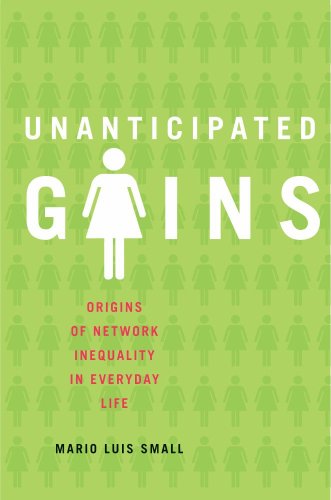Unanticipated Gains: Origins of Network Inequality in Everyday Life
Small, Mario Luis
Oxford University Press USA,
2009
9780195384352 (hb)
 It would be easy on first reflections to dismiss Unanticipated Gains as telling us what we already know. Its central thesis is the larger your social circle the more access you have to gather resources from others. Such a claim is far from groundbreaking. Similarly, Small argues childcare centres in New York offer opportunities for the parents to make new friends, find people with knowledge of different areas and receive beneficial information. Few sociologists would be surprised by these findings.
It would be easy on first reflections to dismiss Unanticipated Gains as telling us what we already know. Its central thesis is the larger your social circle the more access you have to gather resources from others. Such a claim is far from groundbreaking. Similarly, Small argues childcare centres in New York offer opportunities for the parents to make new friends, find people with knowledge of different areas and receive beneficial information. Few sociologists would be surprised by these findings.
This, however, is not merely another book about the benefits social capital can bring. It attempts to uncover how ties are created which enable such advantages to exist. Small is concerned less with what he found than the processes which produced that phenomena.
It is difficult to avoid making comparisons to Robert Putnam's Bowling Alone. Putnam provided detailed analysis of the correlation between declining social capital and a lowering of public trust and other socio-economic factors. Putnam's work, however, lacks an empirical analysis of causality or explanation. Putnam's examples could equally be used to argue that as people have grown weary of their neighbours and neighbourhoods they have utilised their time differently. Small examines more personally the role played by civic engagement, using the example of US childcare centres.
Like Putnam, Small uses social surveys to convey the advantages of social capital. Rather than providing a wealth of data, Small delves into unpacking why associations are occurring and their specific consequences. He demonstrates joining such childcare centres does not affect parents' chances of experiencing non-clinical depression, but making friends in those locations significantly decreases the risk. This implies it is not connecting to institutions which is advantageous, but to the individuals within them. Regarding financial hardship, a more complex relationship is observed. Poorer families are less likely to experience poverty if they attend centres, with no additional benefit if they make friends. Richer families, however, gain no benefit from attending such centres but are less likely to suffer financial hardship if they make friends there. Such findings contextualise more fully those relationships Putnam found, implying a distinction between institutional social capital and personal networks.
This interplay between connections to individuals and to institutions is centralised within the publication, which is largely split into two sections around these roles. The differences, however, are shown as interrelated rather than separate. Small argues those institutions doing the most to bring parents together will provide the strongest rewards to individuals through formalising interactions and generating mutual trust and kinship. Meanwhile, centres are viewed as conduits of individuals, enabling information providers, voluntary groups, advertisers and educators to contact their target audiences. This is not a text which will fundamentally alter the way people perceive social capital, simply reaching the conclusions we would expect from combining the quantitative social capital literature with case studies on support networks. But that is not the contribution Small is hoping to make here. Rather, he proposes an approach to understanding social capital which mixes statistical analysis with interviewing subjects. The book contains a level of detail of both methodologies to leave readers wanting to know more of their speciality but without feeling overwhelming by the other. In many ways just 197 pages (excluding the excellent detailed appendices) leaves the reader pining for more. A lot is cramped into those well-constructed pages. This book could well become one of those 'classic studies' where the conclusions are largely overlooked but the methodology employed can instruct a great many projects and research areas. This shows exactly how collaborations between ethnographers and statisticians can further the study of social capital and get closer to understanding how it is operates in practice. Small should be congratulated for performing both roles so splendidly.
Reference
Putnam, R. (2000) Bowling Alone. London: Simon & Schuster.
Dave Griffiths
University of Stirling

